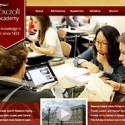When we design logos for our clients we focus on a few things. In this logo design tips article you will see just where our focus is, our process, and how to achieve results time and time again.
Here are our logo design tips (thankfully not 101 to remember!)
- Keep it simple – use just one element of the logo that is the focal point.
- Ensure it renders well for all sizes – how does it look on a business card or on a billboard?
- Make certain it reflects the character of the company – no muted tones for the Latin Salsa School.
- Research – don’t skip this step…ever! – know the company you are designing for and their customers.
- Close down the computer – I know it hurts but trust me, get out that pencil and paper you used in school.
- Use a mind map to get ideas – don’t disregard anything at this stage.
- Sketch anything and everything – they don’t have to be good sketches, just lots of them.
- Keep it simple – did I already say that?
Our tips on the logo design process
We start off by meeting up with the client and get the discussion flowing about just who the company is. We have an initial logo design questionnaire that we send prior to the meeting so that the client has an idea of what we need from them early on.
It might come as a surprise to many but one thing we do not discuss is colors. All elements of the logo are born out of the work we put into the design process, nothing is decided at this stage, not even colors. We want to know the character of the company and the image that the client wants to portray. Are they conservative and strong, vibrant and outgoing, or wacky and wild? What type of business do they operate? What services and/or products does our client offer? Are they a new company or have they been in business for years? How will the logo be used? Etc, etc…
There are hundreds of questions that can be banded around at this stage but it all comes down to trying to understand the client, their business and their customers.
From these discussions we typically spend a few days researching the world that our client operates in – more ammunition for the stockpile of data we are putting together.
We will brainstorm and mind-map, not discarding anything at this stage, to see where the key words take us. Usually a theme or two starts to develop at this early stage and so it is imperative that we have our sketch pads to hand at all times. Constantly creating thumbnail sketches allows us to express our ideas and thoughts without concerns of questions that get in the way at this stage, such as “does this logo design accurately reflect the values of the client?” or “does this logo design indicate to the viewer the type of business that the client offers?”…right now we don’t care! It is all about output, get some ideas out on paper. Yes paper! Not Illustrator or Photoshop but a sketch pad with no wires and no battery. If you spend more than a minute on the sketches at this stage then you are taking things too seriously. This is just to see what springs to mind and find out where you are flowing.
Logo design top tip: Turn off the computer and use a pencil and paper!
Now it is time to iterate on some of these thumbnail sketches, there are usually some strong contenders at this stage and taking them and running with them can often uncover a concept that was previously hidden away.
Start to simplify the ideas, narrow it down to several that have promise and then open up Adobe Illustator and create black and white vector graphics. Still no color!!! It’s the shapes, the lines, the text – think about all of the iconic logos that you know in an instant, they would be just as recognizable in black and white.
Simplify more, expand the concepts and ideas, explore. Be aggressive is stripping away elements and slicing through existing elements that you believe should remain – you will be amazed at what can turn up.
Okay, at some point you will hit on a design that you cannot think of how to improve it, anything you do with that design just detracts from the original quality. This is the logo design that you have created that was always there, always the right choice, it’s the right logo. Oh happy days!
Now sometimes you have a couple of logos that are really “right”, that’s fine – it becomes a battle of the giants and the clients can only win. Often we present just a single logo to our clients, and sometimes the response is “we would like to see three different ideas” – a reasonable request, especially if we were a “logo factory” all you can eat for $175. Here at Boston ID we create everything with a purpose, we do not just churn out ideas. Logos are developed just like a full web application is developed – they are not pulled off a shelf and we do not have a bunch lying around that we can swap the names out on.
Presenting to our clients the workflow of how we got to that single logo design puts them at ease and they then realize the other two ideas that we could have brought with us would only dilute the “right” one.
Sometimes we present a few, sometimes two, often just one. We have yet to present none…thankfully!
Getting to the perfect logo is sometimes a real pain, often fun, and always rewarding.
About the author:
Glenn Hodgkinson is a published author for Digital Classroom Books and teaches Photoshop Classes at the American Graphics Institute.

